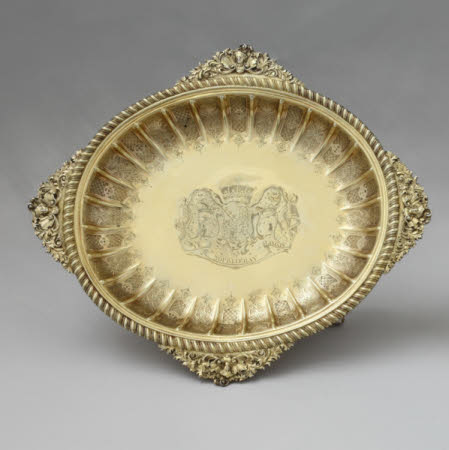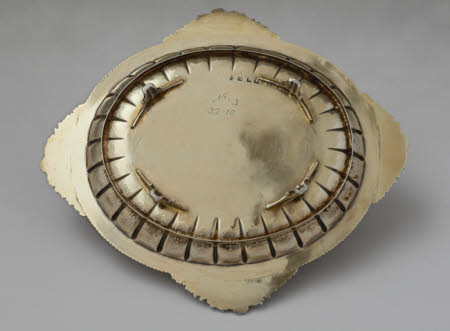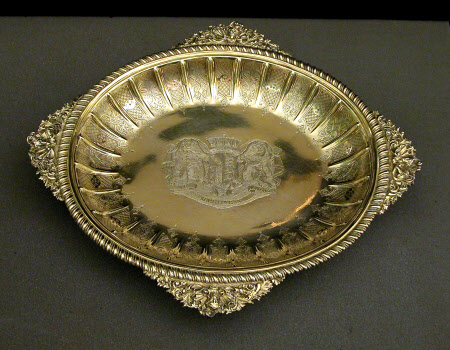Dessert dish
Frederick Kandler
Category
Silver
Date
1766 - 1767
Materials
Silver-gilt
Measurements
4.8 x 34 x 29.8 cm
Place of origin
London
Order this imageCollection
Ickworth, Suffolk
NT 852064.3
Summary
Silver-gilt dessert dish, by Frederick Kandler, 1766/7. The oval dish is raised and has a series of narrow ribs around the perimeter, the compartments thereby created being flat-chased and engraved with foliate strapwork panels, alternately decorated with stylised leaves on matted grounds and trelliswork. There is a cast gadrooned rim and four cast triangular handles, each with a three-dimensional classical bust against an irregular shell and scrolling foliage, the backgrounds matted. The base of the dish is fitted with a seamed bezel and four scroll feet. Heraldry: The centre of the dish is engraved with the quartered shield, supporters and motto of the 2nd Earl of Bristol in an ermine mantling and beneath an earl’s coronet.
Full description
With the de Lamerie dish of 1724 (852064.1) and that by Kandler of 1751 (852064.2), this and its pair (852064.4), which are near exact copies, made up a set of four. It was probably at this point that all of them were gilded and turned over to use as part of Lord Bristol’s now extensive dessert service. With dessert silver increasingly gilded, the number of dishes specifically allocated to the course increased. Thus in 1763 the Earl of Hertford received nine silver-gilt fruit dishes for his embassy to France, two years later his successor, the Duke of Richmond, had twelve and in 1783 the Duke of Manchester, on being dispatched to the same court, was allocated ’20 Scollop’d Dest. [dessert] Dishes’.[1] Lord Bristol, from 1766, had twelve available and he was thus equipping himself for entertaining on an up-to-date ambassadorial scale whilst on the vice-regal throne of Ireland. He was also assiduously keeping up with the rapidly changing dining fashions and he continued to do so, commissioning a further eight silver-gilt dishes in 1769–70 (NT 852067.5-8 and NT 852101.5-8), bringing his total up to that subsequently to be received by the Duke of Manchester. James Rothwell, Decorative Arts Curator January 2021 [Adapted from James Rothwell, Silver for Entertaining: The Ickworth Collection, London 2017, cat. 85, pp. 173-4]. [1] The National Archives, LC 9/45, Jewel Office Delivery Book 1732–93, ff. 207, 238 and 317.
Provenance
Commissioned by the 2nd Earl of Bristol; by descent to the 4th Marquess of Bristol; accepted by the Treasury in lieu of death duties in 1956 and transferred to the National Trust.
Credit line
Ickworth, the Bristol Collection (National Trust)
Marks and inscriptions
Underside: Hallmarks: Fully marked with the date letter ‘L’, leopard’s head, lion passant and maker’s mark ‘FK’ in italics beneath a fleur-de-lis (Arthur Grimwade, London Goldsmiths 1697-1837, 1990, no. 692). Underside: Scratchweight: ‘No. 3 [/] 32=10’
Makers and roles
Frederick Kandler, goldsmith


